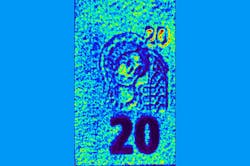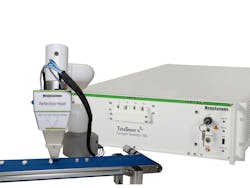Pulses drive industrial innovation: Recent advances in commercial terahertz time-domain systems
For two decades, terahertz technology carried the promise of nondestructive, material-specific insights but remained primarily confined to research labs.
The scientific community was impressed with demonstrations of nondestructive, label-free probing through polymers, coatings, and tablets, resolving structures on picosecond timescales, and detecting spectral fingerprints of water and other materials. But the systems were large, alignment-sensitive, and ill-suited for factory environments where vibration and temperature variations require robustness and pose challenges to 24/7 operation.
In recent years, however, terahertz time-domain spectroscopy (THz-TDS) has undergone a quiet evolution. Leaps in power, scan speed, signal quality, fiber-coupled architectures, mechanical robustness, and software automation have pushed terahertz systems from the research bench to the production line. With higher signal power and dynamic range, fully fiber-coupled sensors, and improved throughput due to novel scan methods, the technology has reached a level of maturity that enables true industrial deployment.1
From perception to reality: The evolution of terahertz systems
In the past, terahertz was seen as expensive, bulky, alignment-fragile, slow, and capricious. In short: Excellent for a Ph.D. thesis but too risky for industrial employment. Today, that perception has fundamentally shifted.
Modern systems deliver the robustness, stability, and usability that production facilities demand, which sets the stage for the series of technical breakthroughs described below.
Key technical breakthroughs
The most important breakthroughs are significant improvements in power and signal quality. Modern photoconductive antennas combined with advances in femtosecond fiber lasers produce stronger broadband terahertz pulses. With lower noise and better dynamic range, measurement outcomes improve significantly across multiple parameters, particularly when working with low-reflectivity or lossy samples.
Current spectrometers also have significantly shorter acquisition times. Within the past five years alone, systems have become an order of magnitude faster, with higher scan speeds and improved dynamic range per single waveform. This reduces the need for averaging and allows for shorter time-window scans, which transforms measurements from seconds into sub-seconds per point. Current speeds, reaching several hundred hertz, enable in-line control and even conveyor-belt scans.
Another key development is the introduction of fully fiber-coupled sensors. These robust, alignment-free, and eye-safe components enable a spatial separation of engine and detector, which allows sensing optics to be positioned flexibly and remotely on the product, while the laser engine remains in stable condition. This greatly simplifies integration with robots, gantries, or enclosures, further supported by longer fiber connections, making line integration straightforward and eliminating alignment issues. Current systems are then easy to use (plug-and-play) for non-experts.
Equally important are advances toward compact footprints, stability, and continuous operation. Modern femtosecond fiber lasers are stable, and combined with compact antennas, they are able to minimize terahertz pulse drift and operate reliably under ambient conditions with significantly reduced warm-up periods. State-of-the-art fiber lasers with no life-limiting components makes them well suited for uninterrupted industrial use.
Finally, data acquisition and analysis are undergoing major advances. Standardized workflows combined with advanced chemometrics, as well as machine and deep learning methods, now enable real-time analysis and result streaming. This makes it possible to continuously monitor properties such as layer thickness, porosity, refractive index, and moisture content directly on the production line.
Industrial impact and value
The result of these improvements is a measurement platform that provides unique value to industry. Terahertz systems reduce the need for multisensor stacks, thanks to their ability to permeate a wide range of materials more deeply than traditional optical and near-field methods—while remaining contact-free and noninvasive. This enables simultaneous detection of multiple critical product attributes, including thickness, porosity, and uniformity, as well as layer counts and defects. Because terahertz is nonionizing, it does not require the regulation and safety measures necessary for x-ray imaging.
High power and speed mean that terahertz measurements can keep pace with industrial line speeds to match the flow of parts on the line, while yielding stable statistics for real-time feedback and process control.
Collaboration spotlight: Pharmaceutical quality assurance
A recent collaboration between the University of Cambridge and Menlo Systems demonstrates how advances in THz-TDS translate directly into applications with significant industrial impact.2 For pharmaceutical manufacturing, the uniformity of tablets, particularly their thickness and porosity, is critical for quality control. Conventional measurement methods are destructive, often require separate, time-consuming procedures for each parameter, are prone to systematic errors, and are not easily adapted for real-time in-line monitoring.
To overcome these limitations, the Cambridge team and researchers from Menlo Systems developed a nondestructive approach that determines both thickness and porosity simultaneously from a single terahertz waveform. Using a transflection setup, in which the terahertz beam passes through the tablet once in transmission and again in reflection, the method extracts both parameters without additional calibration or instrumentation.
A crucial enabler of this advance is the integration of Menlo Systems’ high-power terahertz system, which delivers strong reflection signals and stable waveforms. This ensures accurate measurements and avoids many of the alignment and discrepancy issues that limited other applied methods. The result is a rapid, robust, and calibration-free technique suitable for continuous quality assurance for pharmaceutical production lines.
This work highlights not only the maturation of terahertz technology, but also its value in addressing industrial needs where precision and reliability are essential. By uniting expertise from academia and industry, the project underscores how collaboration accelerates the translation of terahertz research into tangible solutions.
REFERENCES
1. See www.menlosystems.com/products/thz-time-domain-solutions.
2. J. Lee et al., Int. J. Pharm., 20, 681, 125773 (Aug. 20, 2025); https://doi.org/10.1016/j.ijpharm.2025.125773.
About the Author
Emma Caldwell
Emma Caldwell is a technical writer for Menlo Systems (Martinsried, Germany). She holds an MSc in Computational Linguistics, an MA in Logic and Philosophy of Science, and a BSc in Physics from the LMU Munich. She’s been with Menlo Systems since late 2024, working on marketing and science communication.
Prince Bawuah
Prince Bawuah is product manager of Terahertz Systems and Synchronization for Menlo Systems (Martinsried, Germany). Before joining Menlo, he spent five years as a research associate with the Terahertz Applications Group at the University of Cambridge. Since May 2019, he has also held a visiting professorship at the University of Eastern Finland. His academic background includes a Ph.D. and M.Sc. in Physics from the University of Eastern Finland.

